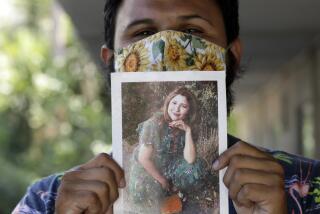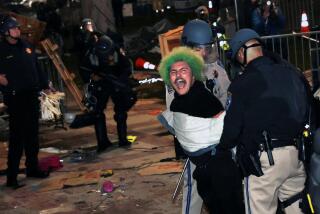Protester wounded by LAPD reflects on two-year legal battle, $1.25-million settlement
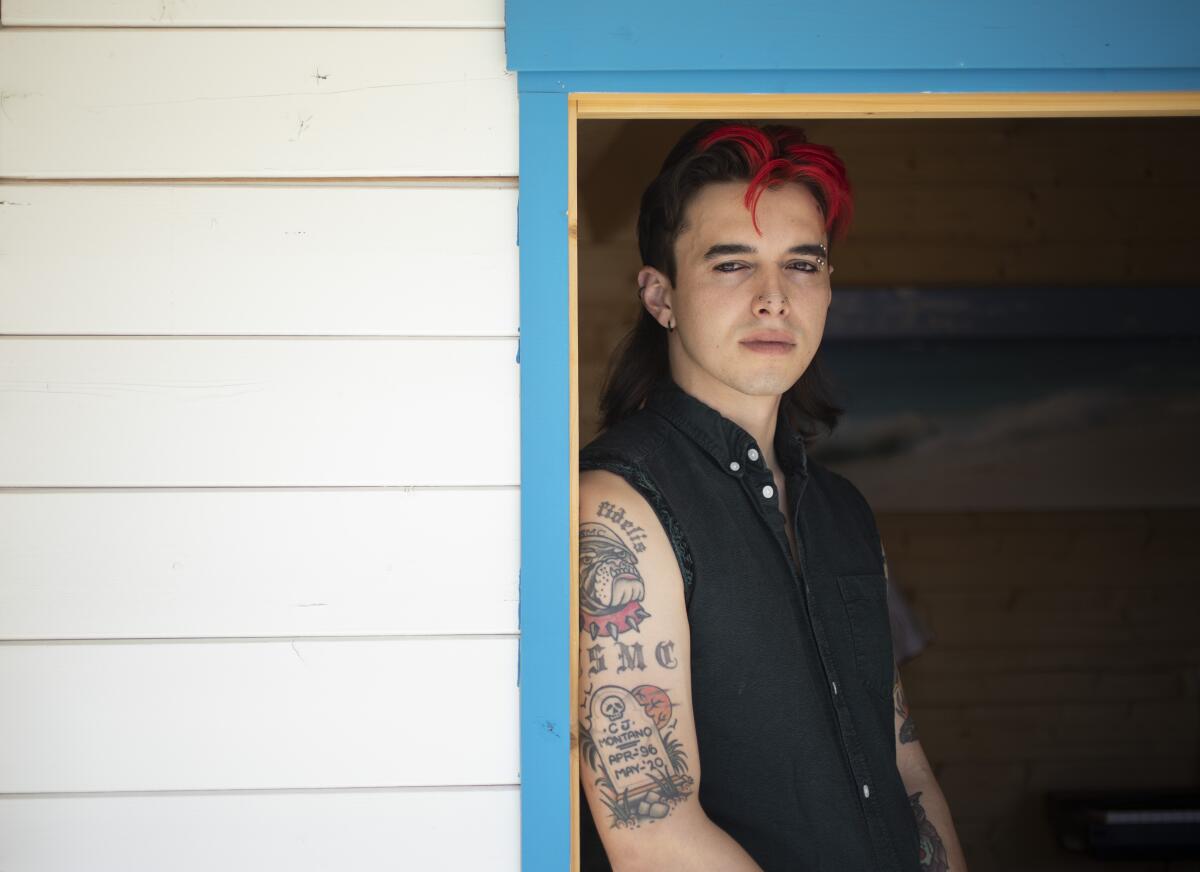
- Share via
Iz Sinistra was entering an exciting new chapter in life in May 2020. He was studying music under the GI Bill after four years in the U.S. Marine Corps, was about to sign a lease on a Los Angeles apartment, and felt happy and independent.
He also felt newly empowered to speak out about important social issues, which he said the Marines had always discouraged. So when George Floyd was killed by police in Minneapolis that month and thousands of people took to the streets of L.A. in protest, Sinistra joined them.
“I felt it was time to go do something that was right,” he said.
What followed would upend Sinistra’s new life.
The protest he attended that day in Pan Pacific Park turned into one of the most volatile in L.A. history. Los Angeles Police Department officers trying to disperse the crowd shot Sinistra in the head with a beanbag projectile, part of an arsenal of so-called less-lethal ammunition used for subduing suspects and quelling unrest.
The incident sent Sinistra to the hospital for four days with bleeding in his brain. He spent the next two years in a blur of medical and legal appointments as he fought to heal and to hold the city accountable.
“That was really hard for me,” he said, “because it was just this period of time when I was feeling all this anxiety and trying to heal, and [it felt like] it was never going to end.”
Today, Sinistra, 26, has reached the other side. In June, he became part of a small but growing first wave of protesters injured by the LAPD in the spring and summer of 2020 who have since been paid cash settlements by the city to resolve claims of excessive force and civil rights violations.
In total, the city has paid out $1.64 million in settlements to 2020 protesters. Of that, $1.25 million went to Sinistra — by far the largest settlement to date. Other cases, including a large one filed by Black Lives Matter Los Angeles and other activist organizations on behalf of many wounded or detained protesters, are still pending.
Sinistra, who speaks in measured tones, is covered in tattoos and has long, dark hair with a streak of red in the front, agreed to discuss the last two years with The Times to shed light on the grueling legal process and the true meaning of his settlement — which is a huge relief, he said, but not what people imagine.
“This isn’t like the lottery,” he said.
One case among many
As the COVID-19 pandemic raged across America, protesters angered by the police killing of Floyd and other Black people held hundreds of demonstrations. In L.A., the vast majority — more than 90% — were peaceful, according to the LAPD.
Some, however, devolved into chaos, as crowds got rowdy, some people damaged property and set fires, and LAPD officers in riot gear moved in to clear the streets using batons and projectile weapons.
The presence of police antagonized the crowds, and officers violated the department’s rules for those weapons as the city instituted nightly curfews and things spiraled out of control. Protesters detained mostly for curfew violations and for failing to disperse were zip-tied, loaded onto buses and left for hours without access to water or bathrooms, also in violation of department standards.
Sinistra’s case — filed under his legal name, C.J. Montano — was one of many lodged against the city in response and is now among a very small number that have been resolved.
A protester named David Bond said he lost part of a testicle after being shot with a projectile the day before Sinistra was wounded; he was paid $300,000. A protester named Wyntergrace Williams said she was shot in the leg with a projectile the same day Sinistra was hurt; she was paid $50,000. A protester named Ezekiel Richardson said he was thrown to the ground and beaten with batons; he was paid $5,000.
The city did not admit wrongdoing in any of those cases. But it settled them after conducting “cost/risk analysis,” which weighed the cost of litigating the cases and the potential for even larger payouts if protesters succeeded at trial, officials said.
The settlements to date do not represent the total sum the city is likely to pay out for the LAPD’s actions in 2020, and could represent just a small fraction. The pending case brought by BLM-LA and its co-plaintiffs seeks class status to represent a huge number of protesters and bystanders with existing or potential claims against the city. If successful, it could cost the city more than all the other cases combined.
The size of Sinistra’s settlement was the result of many factors, including the timing of his claim, the prowess of his legal team, the extent of his injuries and the presence of evidence, including police body-camera video, that showed his shooting was particularly egregious.
Sinistra had been protesting for some time that day when he was shot in the head with a beanbag projectile by a group of LAPD officers who were advancing on a crowd of mostly fleeing protesters. He was also shot in the ribs with a hard-foam projectile.
He was on blood thinners at the time for an unrelated medical issue, so the impact to his head caused serious bleeding in his brain. He was hospitalized for four days with more than half a dozen staples in his forehead, which would later form a large, half-circle scar.
In part because of Sinistra’s status as a former Marine, his case immediately captured public attention. And it attracted even more attention about two months later, when the LAPD released the body-camera video.
The video showed Sinistra standing in the street at a distance from the advancing officers. In the footage, he was slowly moving backward and had his hands up — representing no immediate threat — when he was shot.
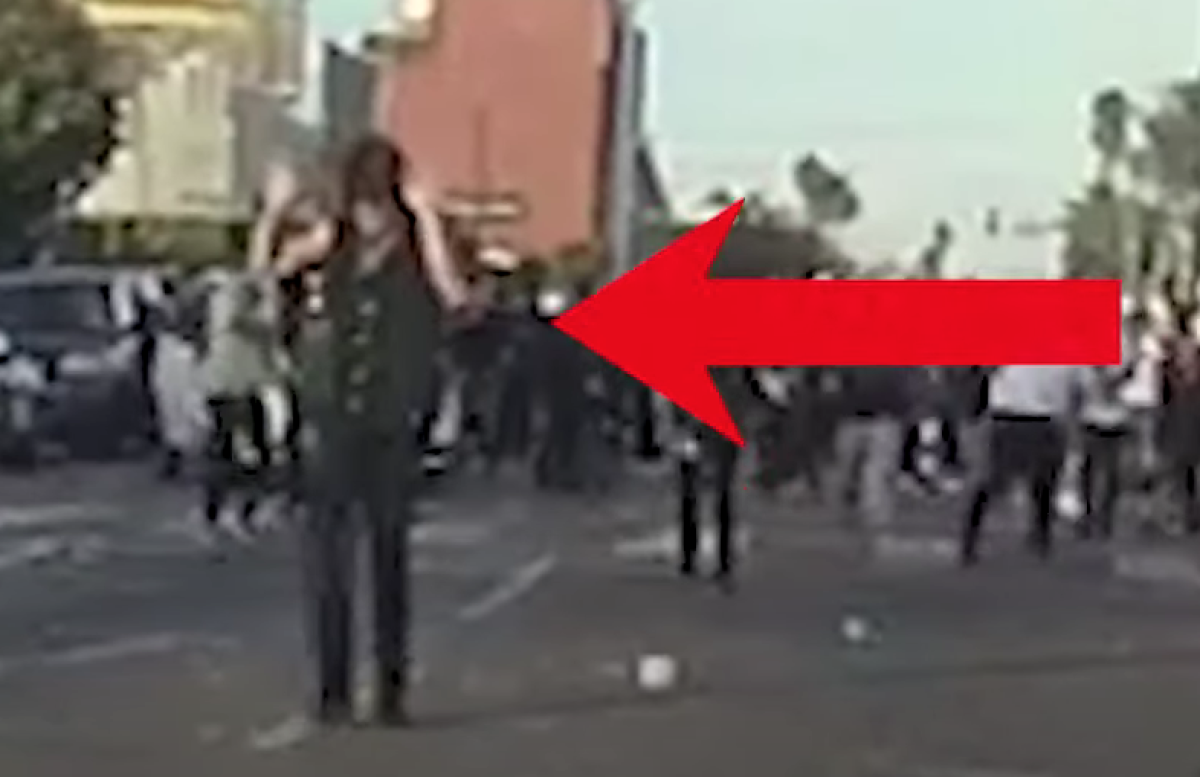
After a lengthy internal investigation, the Police Commission ruled in May 2021 that several officers involved in the incident had violated department policy, including the officer who fired the beanbag round and claimed he was aiming at someone beyond Sinistra. A sergeant also was faulted for having “contributed to confusion and doubt” among his officers as to how the projectile weapons were meant to be used.
Under no circumstances are LAPD officers allowed to shoot protesters in the head with projectiles, according to department policy. They also aren’t supposed to shoot people who are fleeing or who don’t represent a threat.
In the aftermath of the Pan Pacific Park protest and others that year, the LAPD changed its policies around projectiles and increased officer training on the weapons. It barred the use of beanbag rounds for crowd control. One factor in the policy changes was the BLM-LA case, in which a judge issued a temporary restraining order that placed various new restrictions on the use of such weapons for crowd control.
Sinistra’s life, meanwhile, was flipped upside down as his injuries took their toll, he said. Gone was the newly independent life he’d carved out for himself just before he was shot.
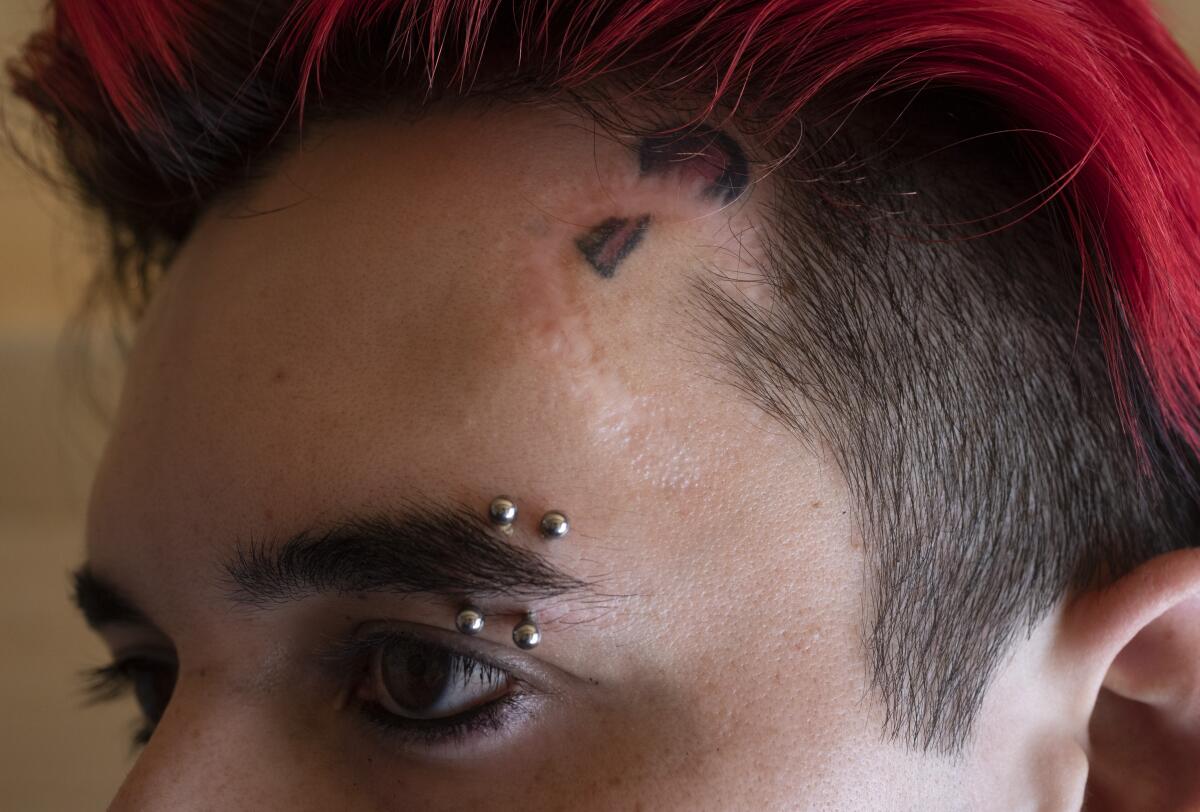
His brain injury caused intense vertigo, he said, so bad that he couldn’t work out anymore, couldn’t carry anything heavy and couldn’t drive for the better part of a year. He still walks with a cane, despite intensive physical therapy, he said.
He started having difficulty reading and problems with his memory and concentration, which he said forced him to drop out of school. Suddenly, he had no choice but to rely on his family for support, and he moved back to his parents’ home in Thousand Oaks.
“It really made me dependent upon everyone,” he said. “I couldn’t do anything by myself.”
Sinistra’s anxiety, which he had struggled with before the shooting, greatly intensified, he said. He became less outgoing and more cautious. The process of suing the city and Police Department, which placed him under intense scrutiny, didn’t help.
“The whole process ... was really anxiety inducing,” he said. “My life was being dug into.”
From lawsuit to settlement
Monique Alarcon, one of Sinistra’s attorneys, said his case was strong for several reasons, including all the evidence that his shooting was in clear violation of department policy.
Still, getting to a settlement was tough.
The COVID-19 pandemic caused delay after delay in the proceedings. Several of the officers involved hired their own attorneys, and the city ultimately hired outside counsel as well, which further complicated the legal process.
The city delved back through hours and hours of video trying to re-create Sinistra’s actions — not just around the time he was shot, but during the entire day. Officials highlighted a situation earlier in the day, in which Sinistra had pulled a barrier into the street, as evidence he was not just a peaceful protester, but causing trouble.
Alarcon and Sinistra’s other attorneys framed the city’s efforts as a distraction.
“They tried to say, ‘Well, he was doing all these things, he was running around in the street, he wasn’t innocent,’” Alarcon said. But “that really had no bearing on the case.”
The city also went to great lengths to analyze Sinistra’s mental and physical well-being, refusing to rely on his own doctors — including at the Department of Veterans Affairs — to diagnose the effects of his injuries on his health and future well-being, which would be the focus of any settlement.
One of the most difficult parts of the case, Sinistra said, was having to submit to medical and psychological evaluations by the doctors hired by the city, who he felt were focused solely on poking holes in his story and his injury claims — not on helping him get well.
“It was really weird to go to doctors who didn’t want to help you, who were working against you,” he said. “That was really tough for me.”
The case consumed much of Sinistra’s attention. His medical care consumed a lot too.
Sinistra had to go through physical therapy for his vertigo, including “balancing exercises for months and months and months,” he said. He also had to go through cognitive therapy, to regain his short-term memory.
Sinistra also underwent post-traumatic stress disorder therapy through the VA. And he said he endured death threats online from people who had heard about his case and felt he deserved to be hurt — or even deserved to have been shot with a real bullet, rather than a projectile.
“I was a little bit, at the time, honestly worried for my life,” he said.
Looking forward
Sinistra said he is doing much better now. The therapy helped, on all fronts, and he’s regained much of the independence that he’d lost.
Under a Marine Corps tattoo on his right arm, he now has another of a tombstone with his legal name — which he said he changed for family reasons — and a death date of May 2020, the major “turning point” in his life.
He’s gotten a job at a music studio setting up equipment for bands and assisting the owner, he said, and is considering going back to music school. He doesn’t know exactly what he wants to do in the future, but he wants it to involve music.

The settlement has relieved a lot of his anxiety, he said, though it’s not the windfall people think.
First, there are medical liens on the settlement from the VA, which wants to be repaid for the care it provided in relation to the shooting. Alarcon said the amount that will be taken by the VA is the subject of ongoing negotiations.
There are other costs that have piled up in the last two years, when Sinistra wasn’t working, he said. And Alarcon and Sinistra’s other attorneys will take a “significant” but unspecified amount of the settlement, as well, though Sinistra said they “deserve every penny and dime that they’ve worked for.”
What’s left of the money, he said, is mostly an insurance policy against future debt.
Sinistra said his medical needs moving forward are hard to know, though his access to care through the VA will help him address them. He doesn’t know how long he will have to continue therapy, including for his vertigo, and his doctors have told him that he is now more likely to develop early onset dementia — which could come with substantial costs down the line.
Despite all that, Sinistra said he’s happy about how things have gone, and with the settlement. He doesn’t need some lavish new life, he said.
He just wants to return to the one he lost.
More to Read
Sign up for Essential California
The most important California stories and recommendations in your inbox every morning.
You may occasionally receive promotional content from the Los Angeles Times.

